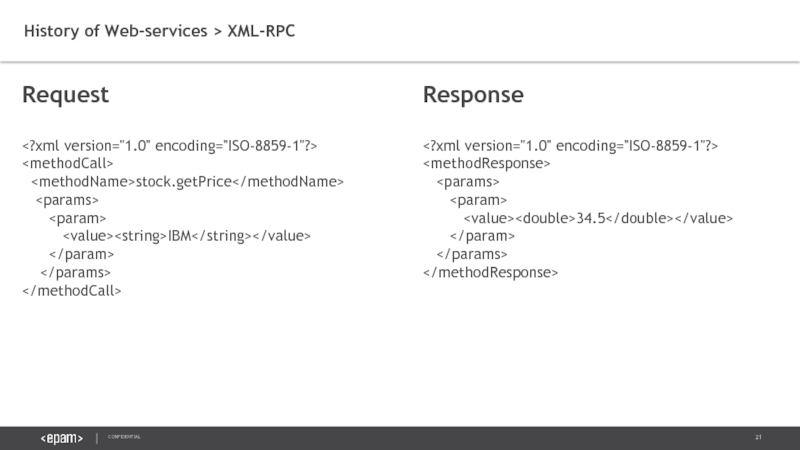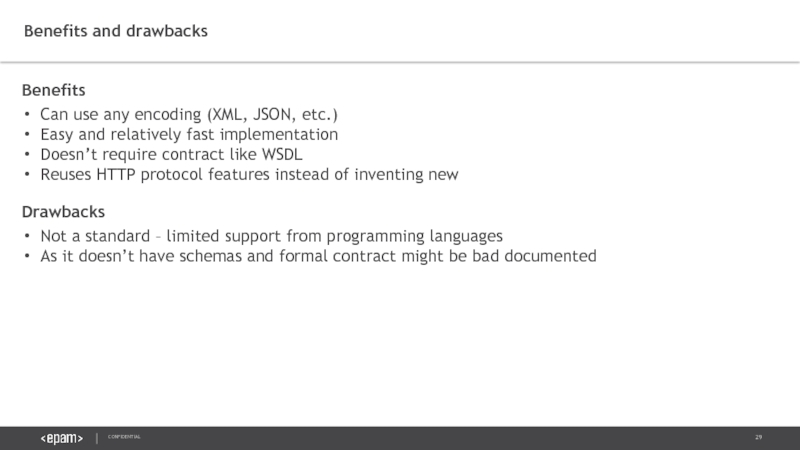- Главная
- Разное
- Дизайн
- Бизнес и предпринимательство
- Аналитика
- Образование
- Развлечения
- Красота и здоровье
- Финансы
- Государство
- Путешествия
- Спорт
- Недвижимость
- Армия
- Графика
- Культурология
- Еда и кулинария
- Лингвистика
- Английский язык
- Астрономия
- Алгебра
- Биология
- География
- Детские презентации
- Информатика
- История
- Литература
- Маркетинг
- Математика
- Медицина
- Менеджмент
- Музыка
- МХК
- Немецкий язык
- ОБЖ
- Обществознание
- Окружающий мир
- Педагогика
- Русский язык
- Технология
- Физика
- Философия
- Химия
- Шаблоны, картинки для презентаций
- Экология
- Экономика
- Юриспруденция
Web services. Part 1. Confidential презентация
Содержание
- 1. Web services. Part 1. Confidential
- 2. Part 1 What Are
- 3. What Are Web Services?
- 4. Web Site "Human-oriented". Graphical user interface
- 5. Web Service View Get chart
- 6. Data aggregation services “Everything” Web
- 7. Services are everywhere. Why? Database
- 8. Reason #1: Common API
- 9. Reason #2: High compatibility
- 10. Reason #3: Black box Internal implementation
- 11. Reason #4: Security Web
- 12. Open infrastructure Platform and language transparency Modular design Benefits
- 13. Integrating network-accessible services, which are
- 14. DCE/RPC History of Web-services early 1990s
- 15. History of Web-services > DCE/RPC > IDL
- 16. History of Web-services DCE/RPC MSRPC early 1990s soon
- 17. History of Web-services DCE/RPC MSRPC CORBA early 1990s soon October 1991
- 18. History of Web-services DCE/RPC MSRPC CORBA COM/OLE early 1990s soon October 1991 1993
- 19. History of Web-services DCE/RPC MSRPC CORBA COM/OLE
- 20. History of Web-services DCE/RPC MSRPC CORBA COM/OLE
- 21. History of Web-services > XML-RPC Request
- 22. History of Web-services > XML-RPC > Datatypes
- 23. History of Web-services > XML-RPC vs
- 24. Benefits and drawbacks Benefits Robust
- 25. XML-RPC Demo
- 26. History of Web-services DCE/RPC MSRPC CORBA COM/OLE
- 27. History of Web-services DCE/RPC MSRPC CORBA COM/OLE
- 28. REST Request/Response Example Request
- 29. Benefits Can use any encoding (XML,
- 30. History of Web-services DCE/RPC MSRPC CORBA COM/OLE
- 31. History of Web-services DCE/RPC MSRPC CORBA COM/OLE
- 32. SOAP Request/Response Example Request
- 33. Benefits Robust standard with long history
- 34. Web Services Types By invocation target
Слайд 2
Part 1
What Are Web Services?
Services are everywhere. Why?
Web-services and SOA
History
XML-RPC
Agenda
Слайд 3
What Are Web Services?
“Web service is a software system designed
By W3C
“Web Services are technology that allows applications to communicate with each other, regardless of the environment via protocols and web interfaces.”
By Wiki
Слайд 4Web Site
"Human-oriented".
Graphical user interface (GUI).
Web Service
Software-oriented.
Thus, no GUI / visuals.
?
Web site
Слайд 5
Web Service View
Get chart
190 x 400 px
Get chart
300 x 200 px
Get
250 x 400 px
Charts Web Service
Financials Web Service
Preference Web Service
Слайд 7
Services are everywhere. Why?
Database
Server
Desktop
Application
Web
Application
User
File Server
Web Service
Слайд 8
Reason #1: Common API
Web services are platform-independent.
Different (often incompatible) platforms can
Services are everywhere. Why?
Web Service
Слайд 9
Reason #2: High compatibility
Web services often use simple trusted technologies –
HTTP (port 80) is often open even in high-security systems and firewalls.
Services are everywhere. Why?
Web Service
Слайд 10Reason #3: Black box
Internal implementation is hidden from clients.
Internal system(s) may
Database
Server
Desktop
Application
Web
Application
File Server
Web Service
Services are everywhere. Why?
Слайд 11
Reason #4: Security
Web service API defines allowed manipulations.
This provides limited access
Services are everywhere. Why?
Database
Server
File Server
Web Service
Слайд 13
Integrating network-accessible services, which are interoperable because each has an interface
System, services as building block components may be characterized as unassociated and loosely coupled.
Web services and SOA
Слайд 15History of Web-services > DCE/RPC > IDL
/* echo.idl */
[uuid(2d6ead46-05e3-11ca-7dd1-426909beabcd), version(1.0)]
interface echo {
const long int ECHO_SIZE = 512;
void echo(
[in] handle_t h,
[in, string] idl_char from_client[ ],
[out, string] idl_char from_server[ECHO_SIZE]
);
}
Слайд 19History of Web-services
DCE/RPC
MSRPC
CORBA
COM/OLE
MSRPC + COM/OLE = DCOM
early 1990s
soon
October 1991
1993
1993
Слайд 20History of Web-services
DCE/RPC
MSRPC
CORBA
COM/OLE
MSRPC + COM/OLE = DCOM
XML-RPC
early 1990s
soon
October 1991
1993
1993
1998
Слайд 22History of Web-services > XML-RPC > Datatypes
Integer: or
Boolean:
String:
Double:
Date/time:
Base64:
Struct:
Array:
Nil:
Слайд 23
History of Web-services > XML-RPC vs DCE/RPC
XML-RPC
Text
HTTP (later SMTP)
DCE/RPC
Binary
Any other
Слайд 24
Benefits and drawbacks
Benefits
Robust standard with long history and solid support from
XML-RPC doesn’t need in general any additional “contract” like WSDL, WADL etc.
XML-RPC supports all basic datatypes “out of box”
Drawbacks
XML is too verbose (in comparison with JSON)
Usage of custom datatypes is complicated
Слайд 26History of Web-services
DCE/RPC
MSRPC
CORBA
COM/OLE
MSRPC + COM/OLE = DCOM
XML-RPC
SOAP 1.0
early 1990s
soon
October 1991
1993
1993
1998
Sep 13,
Слайд 27History of Web-services
DCE/RPC
MSRPC
CORBA
COM/OLE
MSRPC + COM/OLE = DCOM
XML-RPC
SOAP 1.0
REST
early 1990s
soon
October 1991
1993
1993
1998
Sep 13,
2000
Слайд 28
REST Request/Response Example
Request
POST /stock
Host: www.stocks.com
Authorization: Basic xxxxxxxxxxxxxxxxxxx
Accept: application/json
Content-Length: nnn
Content-Type: application/json
{
“name”:
“price”: “34.5”
}
Response
HTTP/1.1 201 Created
Content-Type: application/json
Content-Length: nnn
{
“name”: “IBM”,
“price”: “34.5”
}
Слайд 29
Benefits
Can use any encoding (XML, JSON, etc.)
Easy and relatively fast implementation
Doesn’t
Reuses HTTP protocol features instead of inventing new
Drawbacks
Not a standard – limited support from programming languages
As it doesn’t have schemas and formal contract might be bad documented
Benefits and drawbacks
Слайд 30History of Web-services
DCE/RPC
MSRPC
CORBA
COM/OLE
MSRPC + COM/OLE = DCOM
XML-RPC
SOAP 1.0
REST
SOAP 1.1
early 1990s
soon
October 1991
1993
1993
1998
Sep
2000
May 8, 2000
Слайд 31History of Web-services
DCE/RPC
MSRPC
CORBA
COM/OLE
MSRPC + COM/OLE = DCOM
XML-RPC
SOAP 1.0
REST
SOAP 1.1
SOAP 1.2
early 1990s
soon
October
1993
1993
1998
Sep 13, 1999
2000
May 8, 2000
June 24, 2003
Слайд 32
SOAP Request/Response Example
Request
POST /stock HTTP/1.1
Host: www.stocks.org
Content-Type: application/soap+xml; charset=utf-8
Content-Length: nnn
Response
HTTP/1.1 200 OK
Content-Type: application/soap+xml; charset=utf-8
Content-Length: nnn
soap:encodingStyle="http://www.w3.org/2001/12/soap-encoding">
Слайд 33
Benefits
Robust standard with long history and solid support from nearly all
WSDL allows automatic method generation and serves as documentation even if there’s no documentation
Allows much more functionality in comparison with XML-RPC
Supports all basic datatypes “out of box”
Allows usage of custom data (XSD-defined)
Drawbacks
XML is too verbose (in comparison with JSON)
Relatively time-consuming development (requires WSDL, XSD)
Standard is too universal – most services don’t use all features
Benefits and drawbacks
Слайд 34
Web Services Types
By invocation target type:
Method call (XML-RPC)
Message transfer (SOAP)
Resource manipulation
Each Web Service relies on at least two protocols:
Data encoding protocol
Determines how data is represented.
Transport protocol
Determines how data is transmitted.














![History of Web-services > DCE/RPC > IDL/* echo.idl */ [uuid(2d6ead46-05e3-11ca-7dd1-426909beabcd), version(1.0)] interface echo { const](/img/tmb/5/476904/bbc63c72292c1b3a70448532ab477593-800x.jpg)
























